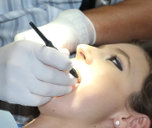
In contrary to the removable dental braces, the fixed ones are put on by an orthodontist for the whole period of the treatment. Nowadays, patients opt for them rather than for the removable braces because the treatment is noticeably shorter and more effective with the fixed braces.
Fixed braces are used for straightening the dental arch and the crooked teeth. Braces functioning is based on the basic laws of physics, in particular on the Newton's third law which says that for every action there is a reaction which is equal in size but opposite in direction.
Hence, it is so important to install the braces appropriately, so as to make it move the teeth (the dental arch) in the right direction. Braces are usually attached in two different ways. They are attached partly to the molar teeth and partly to the opposite side of the beard, skull or neck.
What do fixed braces consist of?
The fixed braces consist of archwires, brackets, bands and other elements made by the orthodontists. Bands are bonded directly to the molar teeth and the correction of a malocclusion depends mainly on them (a point of orthodontic force application). Nowadays, the brackets (bands) are more elastic than they used to be in the past but they still look quite unattractive.
They are made from ceramic, plastic, metal and sapphire. There are also available braces for allergic patients which are devoid of any nickel elements, as well as ceramic braces, ceramic braces with metal slot, metal self-ligating braces, metal Damon system braces or clear braces.
Brackets can be silver, gold or tooth-colored. Moreover, the archwire is inserted into the bracket slot by means of the o-rings, which may have the color of the brackets or any other color chosen by the patient.
The elements in the fixed braces are often replaced. The only element that is fixed to the teeth for the whole period of the treatment is the bracket. The orthodontic (elastic) ligature, which keep the archwire in the brackets, is replaced during every visit to the orthodontist's office. The third fixed element of the braces - the archwire - is replaced a few times during the course of the treatment.
Types of archwires
The dental archwires can be constructed from one wire or from a couple of tiny wires twisted together. In the latter case, the archwire consists of a couple (usually three) of tiny wires of about 0,008 inches in thickness. In the case of a coaxial wire there are more tiny wires twisted over a main wire.
Conventional braces are made from a rectangular wire which is braided from many thin wires of the thickness of: 0,016 x 0,016, 0,016 x 0,022, 0,017 x 0,025 inches. The doctor bends the wire and forms various loops, then he puts different kinds of springs over the wire.
Functional appliances are made from a round wire of 0,038 inches in thickness. These are lingual braces and most popular kinds of them are the palatal bars. They are used in order to expand the upper dental arch.
Article URL: https://www.dentist-pro.com/article,Fixed-braces.html



Add comment